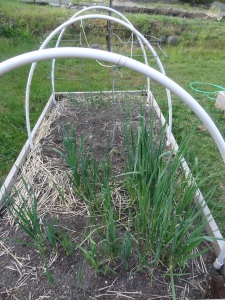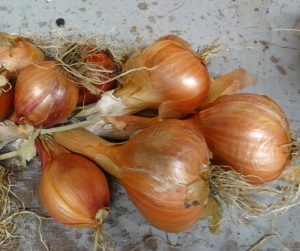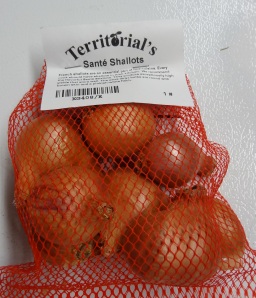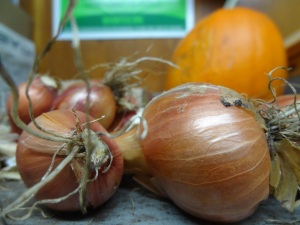I’m new to growing shallots. During September last year I planted my first batch of shallots and then harvested them in mid-June. I picked French shallots from Territorial Seeds and paid $20 for 1 pound of them. I ended up harvesting just over 37 ounces of shallots, which sounds great until you think about how much shallots cost at the store. At Amazon Fresh (available in Seattle and LA) organic shallots cost $7.97 per pound, putting my harvest at $18.56. However I’m pretty sure I can get organic shallots at my local Whole Foods for something closer to $3 per pound which drops my harvest value to about $7. What I don’t know is what variety I can buy at the store and whether or not the one I planted is “better.” Not that it really matters to me. I love shallots and put them in everything so I just want more!
So I did some research. I combed through 4 different books and countless websites, blogs and gardening forums. Here’s what I came up with. Please note that I plant bulbs and not seeds, which need to be planted differently.
- Shallot bulbs should be planted in the fall if you live in an area that does not have an extreme winter. There seemed to be some discrepancy as to whether or not they should go in before or after the first frost. I have decided I don’t care and will just try to find a time when it’s not raining in the next 2 weeks.
- Well-drained soil is key! Soil that is too wet and cannot drain will lead to bulbs that rot. To help keep your bulbs nicely drained you can dig some shallow troughs and plant the bulbs in the mounds in between.
- Bulbs should be spaced 6 inches apart (though I found everything from 4 to 10 inches) in rows that are 12 to 18 inches apart. I think I will plant my rows 18 inches apart because multiple sites said that shallots grow well in the company of mixed greens. I will plant my mixed green seeds in the troughs.
- Shallot bulbs should be put in the ground root end down and the tip of the bulb should be anywhere from just barely covered with soil to 0.5 inches deep. I think the message here is not too deep. And if you’re a mulcher, you should wait until the shoots are a few inches high.
- Shallots should be watered initially until they are well established and then only watered when they get dry. Again too much water will make them rot, so you want consistent watering that allows them to dry out a bit.
- Everyone seemed to have their own opinion on fertilizing. Some recommended no fertilizer whatsoever and some places said to fertilize in the spring. I most likely will put some slow-release, organic fertilizer in before planting and then give it a light fertilizing in the spring.
- Weed, weed, weed. You’d think this would be a general rule for gardening, but a lot of stuff will tolerate some weeds hanging around. Shallots apparently have a shallow root system and weeds can really compete for water and nutrients (or so many websites said). Just make sure when you weed that you don’t accidentally pull out a shallot shoot.
- Many sources will say that shallots don’t flower, or rarely flower. Mine flowered this year and because I had no idea how to handle it I ended up harvesting too early. If yours flower you should NOT FREAK OUT like I did. The stalk that is flowering should be cut off as close to the bulb as possible, and you should do this as soon as you notice any flowering. Flowering will deplete the bulb, making it smaller and more prone to rotting after harvest.
- Shallots are ready for harvest sometime during the summer (there were many comments anywhere from early to late) when the stalks turn yellow and/or brown and die.
- Dig up your shallots with a pitchfork or some other tool that will allow the bulbs to come out as undamaged clumps. Separate the clumps into bulbs and allow to cure. Curing means the bulbs need to be in a dry place with good air circulation for roughly a month in a single layer. This is vital and will allow the shallots to store for up to 8 months.
I think I know where I went wrong. I harvested at the wrong time because I freaked out at the flowering. I didn’t weed as much as I should have and I planted them too close together. We’ll see how it goes this time around.



